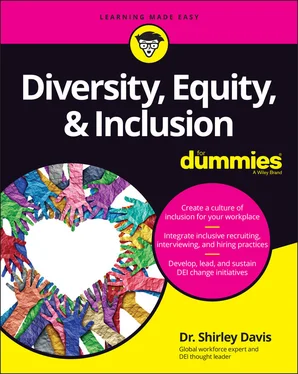Dr. Shirley Davis - Diversity, Equity & Inclusion For Dummies
Здесь есть возможность читать онлайн «Dr. Shirley Davis - Diversity, Equity & Inclusion For Dummies» — ознакомительный отрывок электронной книги совершенно бесплатно, а после прочтения отрывка купить полную версию. В некоторых случаях можно слушать аудио, скачать через торрент в формате fb2 и присутствует краткое содержание. Жанр: unrecognised, на английском языке. Описание произведения, (предисловие) а так же отзывы посетителей доступны на портале библиотеки ЛибКат.
- Название:Diversity, Equity & Inclusion For Dummies
- Автор:
- Жанр:
- Год:неизвестен
- ISBN:нет данных
- Рейтинг книги:3 / 5. Голосов: 1
-
Избранное:Добавить в избранное
- Отзывы:
-
Ваша оценка:
- 60
- 1
- 2
- 3
- 4
- 5
Diversity, Equity & Inclusion For Dummies: краткое содержание, описание и аннотация
Предлагаем к чтению аннотацию, описание, краткое содержание или предисловие (зависит от того, что написал сам автор книги «Diversity, Equity & Inclusion For Dummies»). Если вы не нашли необходимую информацию о книге — напишите в комментариях, мы постараемся отыскать её.
Diversity, Equity & Inclusion For Dummies,
Diversity, Equity & Inclusion For Dummies
Diversity, Equity & Inclusion For Dummies — читать онлайн ознакомительный отрывок
Ниже представлен текст книги, разбитый по страницам. Система сохранения места последней прочитанной страницы, позволяет с удобством читать онлайн бесплатно книгу «Diversity, Equity & Inclusion For Dummies», без необходимости каждый раз заново искать на чём Вы остановились. Поставьте закладку, и сможете в любой момент перейти на страницу, на которой закончили чтение.
Интервал:
Закладка:
Isms and phobias
 In simplest terms, isms are forms of oppression and discrimination.
In simplest terms, isms are forms of oppression and discrimination.
Following are some of the most common isms:
Ableism: Discrimination or prejudice against people with disabilities
Ageism: Prejudice or discrimination on the grounds of a person’s age
Classism: Prejudice against or in favor of people belonging to a particular social class
Heterosexism: Discrimination or prejudice against non-heterosexual people based on the belief that heterosexuality is the only normal and natural expression of sexuality
Racism: Prejudice, discrimination, or antagonism directed against a person or people on the basis of their membership in a particular racial or ethnic group, typically one that’s underrepresented or marginalized
Sexism: Prejudice, stereotyping, or discrimination, typically against women, on the basis of sex
A phobia is an unreasonable or excessive fear or hatred of something or someone. While there are many phobias, several are specific to diversity, equity, and inclusion. Examples include:
Homophobia: Dislike, fear, or hatred of or discomfort with people who are attracted to members of the same sex
Transphobia: Dislike or discrimination against trans people or gender nonconforming people because of their gender identity
Xenophobia: Dislike of people from other countries or anyone deemed “foreign” because of their immigrant or visitor status
Islamophobia: Dislike or hatred against anyone practicing or perceived to be a practitioner of Islam because of their religious affiliation
COMBATING FEELINGS OF LOSS AND FEAR AROUND DEI
Loss and fear are often at the core of people’s feelings around DEI practices. It’s the fear that those who benefit from majority-favoring practices and white privilege will lose out on success. But these fears are unfounded. Actually, one workplace leader I know stated that “fear of the unknown could be standing in the way of the success of DEI practices.” One thing to note is that diverse employees recognize that their white counterparts aren’t responsible for the years of inequity experienced by people of color and other underrepresented categories of people, but these white counterparts can be allies to help dismantle those inequitable systems. However, everyone has to recognize that everyone has to participate in the conversation about DEI (that means including white men).
All people experience fear; it impacts everyone, and therefore everyone needs to be engaged in the DEI conversation. Women, people of color, disabled people, and the LGBTQIA+ community fear mistreatment, prejudice, and continued marginalization. White men, especially, fear living and working in a society where they’re no longer the majority. Millennials fear not being respected because of their age. This aspect of humanity can serve as a connection point to help level the playing field in the workplace.
 Belief in these many isms and phobias influence our biases in our everyday life, including the workplace. Recognizing and understanding these beliefs is an important step in our DEI journey so that we become aware of what not to do and what to do more effectively.
Belief in these many isms and phobias influence our biases in our everyday life, including the workplace. Recognizing and understanding these beliefs is an important step in our DEI journey so that we become aware of what not to do and what to do more effectively.
LGBTQIA+
(Adapted from Human Rights Campaign’s and Catalyst’s Glossary of Terms)
An initialism for the community of people who identify as lesbian, gay, bisexual, transgender, queer or questioning, and any other sexual or gender minority. People often refer to the I as “intersex” and the A as asexual. Some of my colleagues also use the IA to refer to inclusion allies.
 The plus symbol (+) at the end of the initialism is significant because it’s a symbol of all things on the gender and sexuality spectrum that have yet to be described or defined. As conversations around sex and gender spectrums continue to evolve, new terms will emerge and become prevalent in this space.
The plus symbol (+) at the end of the initialism is significant because it’s a symbol of all things on the gender and sexuality spectrum that have yet to be described or defined. As conversations around sex and gender spectrums continue to evolve, new terms will emerge and become prevalent in this space.
Originally, the first four letters of the LGBTQIA+ initialism were commonly used to group various sexual and gender minorities. Although it was first considered an evolution toward inclusion, these four letters proved to be limiting to individuals who didn’t identify as lesbian, gay, bisexual, or transgender.
 You can refer to the Human Rights Campaign (HRC; hrc.org) to remain up to date on terms and resources related to LGBTQ issues.
You can refer to the Human Rights Campaign (HRC; hrc.org) to remain up to date on terms and resources related to LGBTQ issues.
Other LGBTQ terms include the following:
Sex: Biological classification of male or female based on reproductive organs and functions.
Lesbian: Women and nonbinary people who are attracted to women may use this term to describe themselves.
Gay: Men, women, and nonbinary who are attracted to people of the same gender may use this term to describe themselves.
Bisexual: A person who is attracted to more than one sex, gender, or gender identity may use this term to describe themselves. These attractions don’t necessarily occur simultaneously, in the same way, or to the same degree.
Transgender: People who feel that the gender assigned to them based on their biological sex is a false or incomplete definition of themselves. Being transgender doesn’t imply any specific sexual orientation. Therefore, transgender people may identify as straight, gay, lesbian, bisexual, and so on.
Queer: This term is often used as a catch-all adjective to describe many people, including those who don’t identify as exclusively straight and/or folks who have nonbinary or gender-expansive identities. This term was previously used as a slur but has been reclaimed by many parts of the LGBTQ movement.
Microaggressions
Microaggressions are subtle verbal and nonverbal slights, insults, indignities, and denigrating messages directed toward a person due to their group membership, often automatically and unconsciously. Microaggressions can be seen as innocent, harmless comments, but they actually reinforce stereotypes and are a form of discrimination.
For example, if you ask the Asian member of your team to complete a task that requires extensive math because you know they’ll be great at it, you probably just made the statement without thinking. You don’t know the Asian member of your team; you just assumed they’d be great at math based on a stereotype. That’s the challenge with microaggressions — they often operate outside of the level of consciousness.
Throughout my career as a woman and a person of color, I’ve experienced many microaggressions at the hands of supervisors, senior leaders, and other authority figures who were from the dominant group of power and privilege in the organization. I’ve been complimented for “sounding white and speaking proper,” been told how articulate I am, and been used as a photo op for the company’s annual report or marketing brochure and as a token for meeting diversity goals. I’ve been present at the table but had my voice be invisible, been designated as the one to go get lunch for all male colleagues — the list goes on. These microaggressions left me feeling used, undervalued, emotionally exhausted, resentful, and hurt.
Читать дальшеИнтервал:
Закладка:
Похожие книги на «Diversity, Equity & Inclusion For Dummies»
Представляем Вашему вниманию похожие книги на «Diversity, Equity & Inclusion For Dummies» списком для выбора. Мы отобрали схожую по названию и смыслу литературу в надежде предоставить читателям больше вариантов отыскать новые, интересные, ещё непрочитанные произведения.
Обсуждение, отзывы о книге «Diversity, Equity & Inclusion For Dummies» и просто собственные мнения читателей. Оставьте ваши комментарии, напишите, что Вы думаете о произведении, его смысле или главных героях. Укажите что конкретно понравилось, а что нет, и почему Вы так считаете.












